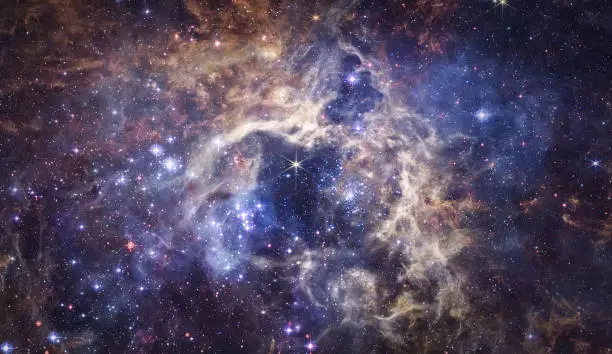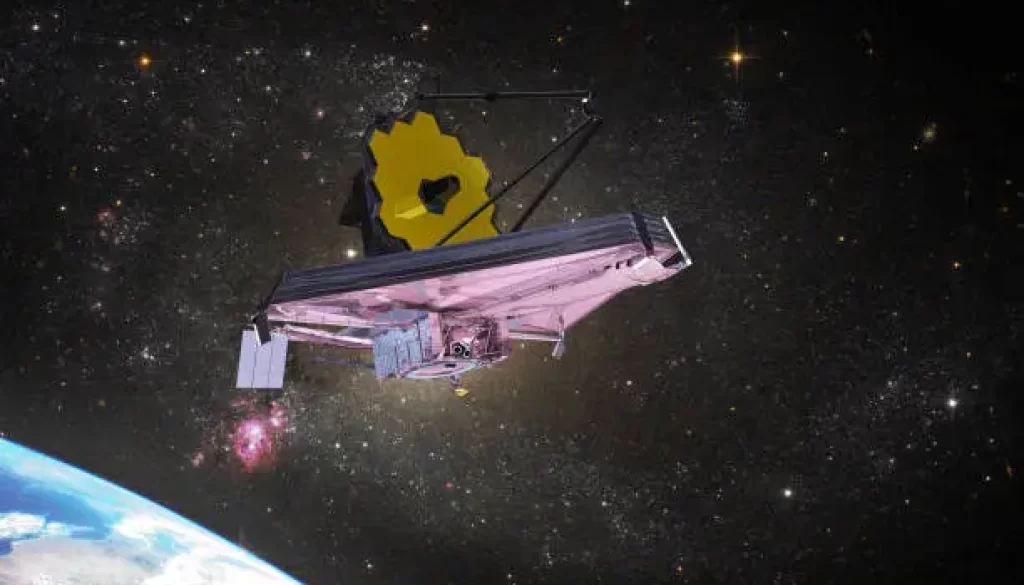Unveiling Cosmic Enigmas: The James Webb Space Telescope’s Odyssey
In the grand symphony of our universe, the early cosmos blazed with intense heat and a dense cacophony of elements. As time gracefully unfolded, temperatures cooled, orchestrating the elegant dance of electrons and nuclei, giving birth to the first atoms.It took hundreds of millions of years for celestial actors to take center stage: the birth of stars and the formation of galaxies.
Unraveling the Cosmic Enigma
Now, let’s embark on an odyssey to unravel the cosmic enigma of how these celestial phenomena came into existence. This remarkable endeavor has been meticulously crafted over two decades, with a colossal budget of 10 billion dollars. Imagine yourself perched 65 million light-years away in the Virgo cluster, equipped with a potent telescope that peers back at Earth.
James Webb Space Telescope
Through its vigilant gaze, you could witness the majesty of the dinosaurs that once roamed our planet. However, formidable challenges await, but take heart, for this remarkable telescope, the James Webb Space Telescope, is our guiding light.

It’s a technological marvel, dwarfing even the renowned Hubble telescope, with its miraculous ability to peer into the realm of infrared light.This spectral dimension allows it to pierce through cosmic veils of dust and witness the celestial birth of stars within the cosmic cauldron. Moreover, it adheres to Einstein’s theory of relativity, tracing the universe’s ever-expanding boundaries, which causes light to shift into the infrared spectrum, the enigmatic realm of redshift.
The Enchantment of the Mirror
But you might wonder, how does this astronomical marvel detect such ethereal light? The answer lies in its colossal mirror, comprised of 18 hexagonal segments, each measuring 1.32 meters in diameter.This ingenious design allows it to fold compactly on Earth and gracefully unfold in the depths of space. With precision finer than a human hair’s width, it meticulously calibrates the mirror segments to perfection.
Capturing Ancient Light
Once harnessed, the light is channeled into a collection of scientific instruments. Leading the pack is NIRCam, the telescope’s near-infrared imager.Armed with ten sensitive detectors, it captures the ancient light from primordial stars and galaxies, akin to celestial time capsules.Yet, NIRCam cannot unveil all the universe’s mysteries. Enter NIRSpec, an instrument designed to operate in the same spectral range.

The Cosmic Shutter System
It unravels the light’s spectrum, deciphering an object’s mass, temperature, and chemical composition, conveyed through spectral lines inscribed by atoms and molecules.
To maximize efficiency and avoid lingering on a single object, NIRSpec employs a remarkable superpower: the Micro Shutter System, boasting an impressive 250,000 shutters that open and close like cosmic eyelids.
The telescope remains vigilant, thanks to the Fine Guidance Sensor, continually adjusting its focus to various celestial targets. Hence, it is a perpetual stargazer.
Enhancing Capabilities
To further augment its capabilities, we have NIRISS, the Near Infrared Imager and Slitless Spectrograph, which captures images and spectroscopic data in the near-infrared spectrum.
To conquer the cosmic obscurations caused by dust clouds, there’s MIRI, the Mid-Infrared Instrument.
It operates in the realm of longer-wavelength infrared light, effectively piercing through cosmic shrouds. However, it requires cooling to an astonishing -266.5 degrees Celsius for optimal performance. This task is handled by the Cryo Cooler, an intricate cooling system.
Strategically Positioned
Positioned at the distant second Lagrange point (L2), located 1.5 million kilometers away from Earth, the telescope deploys an expansive sun shield.
This multi-layered, 21-meter-long, and 14-meter-wide marvel effectively shields the telescope from the Sun, the Moon, and the radiating heat of Earth.
The telescope’s components are ingeniously designed to be foldable, enabling it to be transported into space by the Ariane 5 rocket.
Unlocking Cosmic Mysteries
Now, let’s explore the breathtaking possibilities offered by this celestial voyager. It can capture the faintest whispers of infrared light, even discerning the heat signature of a bumblebee from the lunar distance.
But why bumblebees, you may wonder? This extraordinary telescope can also unveil the secrets of planetary rings.
Searching for Signs of Life
Not just the iconic rings of Saturn but those encircling Uranus, Neptune, and Jupiter. These hidden rings, unseen in the visible spectrum, will finally disclose their mysteries through the telescope’s infrared scrutiny.
The telescope truly shines when it turns its gaze toward exoplanets within the habitable zone.
By studying their atmospheres, it may uncover the chemical signatures that could indicate the presence of life.
Lastly, The James Webb Space Telescope holds the potential to rewrite our comprehension of the cosmos. It can reveal the cosmic tales of star and galaxy births, reshaping the scientific narrative.
The universe guards its enigmas, but with the James Webb Space Telescope as our guide, we are poised to unearth the mysterious truths of the cosmos. So, I hope this article has been informative for you, and I’d like to thank you for viewing.



